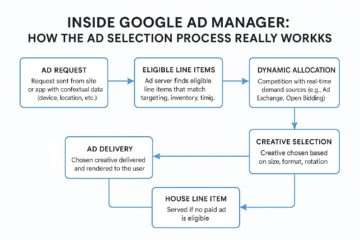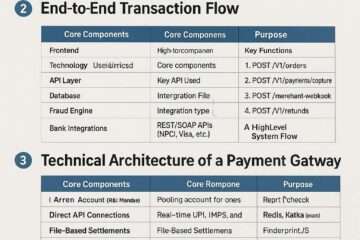

In this part 4 of DV 360 we discuss 20 next important questions related to DV 360 in Programmatic Advertising . Lets discuss them one by one :
1. What is viewability and how does it impact campaign performance in DV360?
Viewability refers to the likelihood that an ad will be seen by a user. In DV360, viewability is measured by how much of an ad appears on the screen and for how long. A high viewability rate means that the ad has a better chance of engaging the audience, which can lead to higher campaign performance. It impacts performance by ensuring that ads are being served in places where they have the opportunity to be noticed, ultimately improving brand awareness and conversions.
2. How can you optimize for conversions within DV360?
To optimize for conversions in DV360, you can:
- Set up conversion tracking and use it to measure the actions users take after interacting with your ad.
- Use automated bidding strategies like “Target CPA” or “Target ROAS” to focus on achieving conversions at a desired cost.
- Adjust audience targeting to focus on high-performing segments.
- Experiment with different ad creatives and formats to see which ones lead to the most conversions.
- Leverage machine learning capabilities in DV360 to automatically adjust bidding and targeting based on performance data.
3. What is the role of machine learning in optimizing programmatic advertising campaigns?
Machine learning in programmatic advertising helps optimize campaigns by analyzing large datasets to identify patterns and predict which factors will drive better performance. It can automatically adjust bids, targeting, and creatives to improve outcomes such as conversion rates, viewability, and return on ad spend (ROAS). DV360 uses machine learning to offer smart bidding strategies, audience targeting, and dynamic creative optimization.
4. How do you use the DV360 bid strategy recommendations for optimization?
DV360 provides bid strategy recommendations based on the performance of your campaign. These recommendations suggest changes to your bid strategy to help you achieve specific goals, such as maximizing conversions or reaching your target cost-per-acquisition (CPA). By reviewing these recommendations, you can adjust your bidding approach to align with the most effective strategies, improving campaign efficiency and performance.
5. What is inventory forecasting in DV360?
Inventory forecasting in DV360 involves predicting the availability of ad inventory across various publishers and channels. It helps advertisers plan their campaigns by understanding how much inventory will be available for targeting specific audiences or placements. This forecasting allows for better budget allocation and campaign pacing, ensuring that ads are shown at the most opportune times.
6. How do you adjust a campaign’s targeting if it’s performing poorly?
If a campaign is performing poorly, you can adjust its targeting in several ways:
- Refine audience targeting by focusing on segments that are more likely to convert.
- Exclude underperforming audience segments.
- Adjust geographic or demographic targeting to focus on regions or groups with higher engagement.
- Experiment with different keywords or placements to reach a more relevant audience.
- Use retargeting to engage users who have previously interacted with your brand.
7. What is the importance of creative testing and optimization in DV360?
Creative testing and optimization are crucial for improving ad performance. DV360 allows advertisers to test different ad creatives to see which ones resonate most with their audience. By analyzing the performance of each creative, you can make data-driven decisions to optimize your ads for better engagement, conversions, and return on investment. This process ensures that your messaging is relevant and compelling to your target audience.
Audience Measurement and Attribution
8. What is cross-channel attribution, and how is it used in DV360?
Cross-channel attribution refers to the process of assigning credit to different marketing touchpoints across various channels, such as display, search, social, and email, that contribute to a conversion. In DV360, cross-channel attribution helps marketers understand the role of each channel in driving conversions and allows for better allocation of marketing spend based on the performance of each channel.
9. How does DV360 use data from Google Analytics for campaign optimization?
DV360 can integrate with Google Analytics to leverage data on user behavior, such as page views, bounce rates, and time on site. By using this data, DV360 can optimize campaign targeting, bidding, and creatives to focus on users who are more likely to convert based on their online behavior. This integration allows for a more holistic approach to campaign optimization, combining website performance insights with programmatic advertising strategies.
10. What are first-touch and last-touch attribution models?
- First-touch attribution assigns 100% of the credit for a conversion to the first interaction a user has with your ad or campaign.
- Last-touch attribution assigns 100% of the credit for a conversion to the last interaction the user has before completing the conversion.
Both models are used to analyze which touchpoint had the greatest influence on a conversion.
11. Explain the concept of multi-touch attribution (MTA) in programmatic advertising.
Multi-touch attribution (MTA) is a more comprehensive model that distributes credit for a conversion across multiple touchpoints in the customer journey. It allows advertisers to understand the contribution of each ad interaction (such as display, search, social) and how they collectively influence the decision to convert. This approach provides a clearer picture of which channels and tactics are most effective at driving conversions.
12. How do you implement a custom attribution model in DV360?
To implement a custom attribution model in DV360, you need to set up a custom model in Google Analytics or use the “Attribution” section in DV360’s reporting tools. You can define the rules for how credit should be assigned across different touchpoints in the customer journey. This allows you to tailor the attribution model to your specific campaign goals and data, such as giving more weight to certain interactions based on your strategy.
13. How do you track and measure the effectiveness of video campaigns in DV360?
To track and measure the effectiveness of video campaigns in DV360, you can use metrics such as video completion rate (VCR), view-through rate (VTR), engagement rate, and conversions. DV360 provides reporting tools that show how users interact with your video ads, including how many users watched the video, whether they engaged with the call to action, and whether they converted afterward.
14. What is an attribution window and why is it important?
An attribution window is the period of time after an ad interaction in which a conversion is attributed to that interaction. It is important because it helps to define the length of time during which a user’s behavior will be considered in determining whether an ad led to a conversion. A longer attribution window may capture more touchpoints, while a shorter one may provide more immediate insights.
15. What role does audience overlap play in attribution?
Audience overlap refers to the situation where the same user is exposed to multiple campaigns or touchpoints within the same or different channels. In attribution, audience overlap is important because it can lead to over-counting the effectiveness of certain campaigns. Properly accounting for audience overlap ensures more accurate attribution by not double-counting the influence of touchpoints on a user’s decision to convert.
Technical Knowledge & Setup
16. What is an ad server and how does DV360 interact with it?
An ad server is a technology platform that stores and delivers digital ads to users across websites, apps, or other media. DV360 interacts with ad servers by using them to serve ads to the appropriate inventory based on targeting parameters and campaign goals. DV360 can also collect data from the ad server for measurement and optimization purposes.
17. What are the different types of creatives you can upload in DV360?
DV360 supports a variety of creative formats, including:
- Display ads (static and dynamic)
- Video ads (pre-roll, mid-roll, post-roll)
- Rich media ads
- HTML5 creatives
- Native ads
- Audio ads
- Custom display templates for personalized creative delivery
18. How do you handle dynamic creative in DV360?
Dynamic creative in DV360 allows for personalized ad experiences based on user data, such as location, behavior, or demographics. You can upload dynamic creatives that automatically adjust content (e.g., images, text, offers) to tailor the ad to each user. You need to set up dynamic templates in DV360 and provide the necessary data feed for the dynamic elements to update based on real-time conditions.
19. What is VAST and VPAID in programmatic advertising?
- VAST (Video Ad Serving Template) is an XML-based framework used for serving video ads across different platforms. It provides a standard format for delivering video ads and tracking their performance.
- VPAID (Video Player-Ad Interface Definition) is a standard that allows for interactive video ads. It enables features like user interaction, engagement tracking, and dynamic content changes during video ad playback.
20. What is a tag in DV360, and how do you implement one?
A tag in DV360 is a piece of code that tracks user interactions with ads or websites. It collects data such as impressions, clicks, and conversions. To implement a tag, you need to add the tag to the relevant pages or ad units in your campaign. This can be done through the DV360 platform or by adding the tag directly to the HTML code of the webpage where the ad is being served.


























































